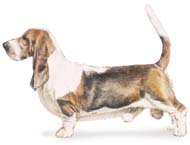INSTANT PROMOTION - LIMITED TIME OFFER - GET YOUR PUPPY COUPON TODAY
Hicksville: 516-938-7877
Lynbrook: 516-825-7877
Hicksville: 516-938-7877
Lynbrook: 516-825-7877
Currently we do not have any Basset Puppies available.
Please complete the form below to be notified when they are back in our stores.

Height: 13 – 15 inches Weight: 40 – 65 lbs.
Colors: Generally black, white and tan, but occasionally lemon and white. They can be any Hound color. Coat: Hard, smooth, short and dense.
Temperament: Basset Hounds are independent, good natured, sociable, and gentle. They can be stubborn when on the scent of an animal, especially deer, in that they are adamant about tracking the scent. With Children: Very good, a delightful pet to children, very gentle with children. With Pets: May show dominance to other male dogs, but can be an entertaining companion to other dogs. Special Skills: Best tracking nose and ability of all breeds except for the Bloodhound, loud bawling voice and very vocal about their moods.
Watch-dog: High – Suspicious of strangers. Guard-dog: Low – Slow in pursuit, or may not pursue at all.
Care and Training: Minimal grooming of the Basset Hound’s coat is needed. They can be massaged or brushed gently to remove dead hairs. Carefully attention should be paid to their long ears. Basset Hounds should be taught basic obedience persistently during their early age as they can be self-willed and when their natural scenting ability tempts them, they will go off in hot pursuit. Plenty of moderate exercise will help keep them fit and trim; long walks or scent games are best for Basset Hounds. Special Needs: Slow-paced but long lasting exercise such as walks, a fence to keep from wandering. Learning Rate: Medium. Obedience – Medium. Problem Solving – Low. Basset Hounds can be difficult to housebreak, but with determination and lively, attention-getting training this Hound can make a very enjoyable, well-trained pet. When trained with a food reward, Bassets tend to forget the job and focus only on the food reward, so careful attention must be paid to the frequency of food rewards and overall method of training.
Activity: Indoors – Low. Outdoors – Medium. Bassets enjoy lounging inside with their family, but will exercise if the opportunity is presented. Basset Hounds enjoy tracking games that allow them to use their remarkable nose, as well as long hikes or walks. Living Environment: Will do well in a house or apartment as they are very sedentary indoors, but they enjoy and need outdoor activities. Daily exercise will help to prevent obesity, as Basset Hounds love food. Bassets also have a tendency to wander, and therefore should be kept within a fenced area.
Health Issues: Compared to other breeds, Basset Hounds are commonly more healthy. Basset Hounds tends to be obese, but this can and should be controlled with proper diet and exercise. Obesity can cause spine and leg problems such as hip and elbow dysplasia. Ears are susceptible to infections, as well as the eyes to glaucoma. May suffer from bloat and skin infections. Bloat is a health issue to most dogs, being the second largest killer of dogs other than cancer, but Bassets can be particularly susceptible to it because of their deep chests. Puppies are often delivered by cesarean section.
Life Span: 10 – 13 years(Few have lived past 14 years) Litter Size: 8 -10
Country of Origin: France History: Basset Hounds appear to have origins that date back to the sixteenth century when French stag hounds were bred to short legged hounds. The Basset Hound can be traced back to the interbreeding of the Basset d’Artois and the Basset Normand. Basset Hounds also largely resembles a dwarfed version of the Saint Hubert Hound of France, and may be a descendent of this breed. In the early development of the Bassets, they were used for hunting small game that was low to the ground, such as rabbits and hares. Bassets were meant to be able to track in thick cover the scent of an animal, but not to kill it. This proved easy for the cumbersome dog, as they are adept to finding the source of a scent, but slow in retrieving anything. After the French Revolution, hunting was a prominent sport in France and the dogs were bred for that very use by French Monks. In 1866 a pair was sent to Britain to Lord Galway, in which the dogs were named Basset and Belle, and in 1872 produced a litter of puppies. The litter was then adopted by Lord Onslow and added to his pack of other Bassets imported from France. At this time Basset Hounds were mostly held by the aristocracy because of the hunting sport they were bred for. In 1892 they were crossed with a Bloodhound which made slight changes to the appearance of the breed. Since then the Basset Hound has made its way to America and seen much popularity among households and has appeared in the media spotlight numerous times.
First Registered by the AKC: 1885 AKC Group: Hound Class: Hound Registries: AKC, ANKC, CKC, FCI (Group 6), KC (GB)